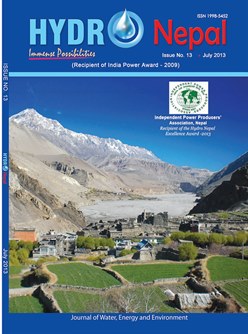An Overview of Glaciers Distribution in the Nepal Himalaya
DOI:
https://doi.org/10.3126/hn.v13i0.10034Keywords:
Glaciers, Himalayas, GOLF, NepalAbstract
Correction: On 7th September 2015, Pei Wang was included as an author on this paper. He was omitted from the paper by mistake. John W. Pomeroy was removed as an author of the paper but was included in the Acknowledgements of the paper (p.26)
Abstract:
Glaciers in the Himalayas are the important resource for fresh water. Continuous releases of the water from these glaciers make an important contribution to the drinking water, agriculture, and hydropower supply of densely populated regions in south and central Asia. Glaciers are not only a necessity for the survival of the people living in the low lying areas but also for their prosperity. Therefore, special attention should be given to detail research in the distribution of the glaciers in the Himalayan region and its surroundings.
Physical parameters of glaciers area, length, depth, elevation profiles were analyzed based on the data provided by WGMS and NSIDC (1989), which was updated in 2012. Machhapuchhre, Thyangbo, Cho Oyu, Taweche, Setta, Tingbo and Kanchanjanga glaciers were found as the smallest glaciers in terms of area (<1km2), mean length (< 2km) and mean depth (40m) in the Nepal Himalaya. Langtang Ngojumba, Barun and Yalung glaciers were found as the largest glaciers in terms of area (>50km2). Large difference between start and end elevation point of glaciers of Khumbu, Ngojumba, Imja, Langtang indicates coverage area profiles are large and located in steep slopes of the Nepal Himalaya, which may result in linear erosions and avalanches. This paper also discusses about the Glacier Lake Outburst Flood (GLOF) in the Himalayan region.
HYDRO NEPAL Journal of Water, Energy and Environment
Issue No. 13, July 2013
Page:20-27
Uploaded date: 3/12/2014
Downloads
Downloads
Published
How to Cite
Issue
Section
License
The copyright of the articles and papers published is held by HYDRO Nepal Journal.
The views and interpretation in this journal are those of author(s), and HYDRO Nepal does not bear any responsibility for the views expressed by authors in the journal.




